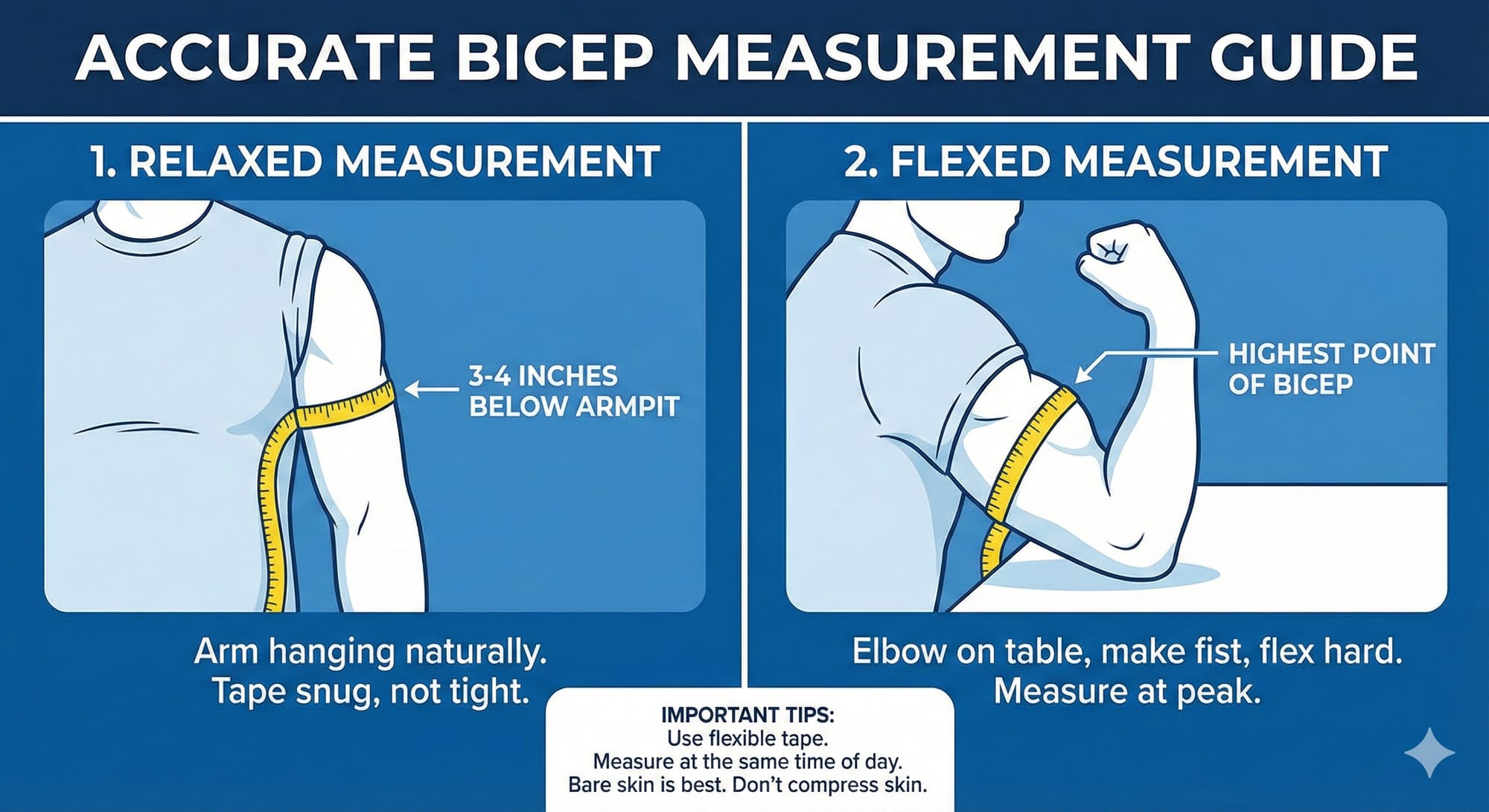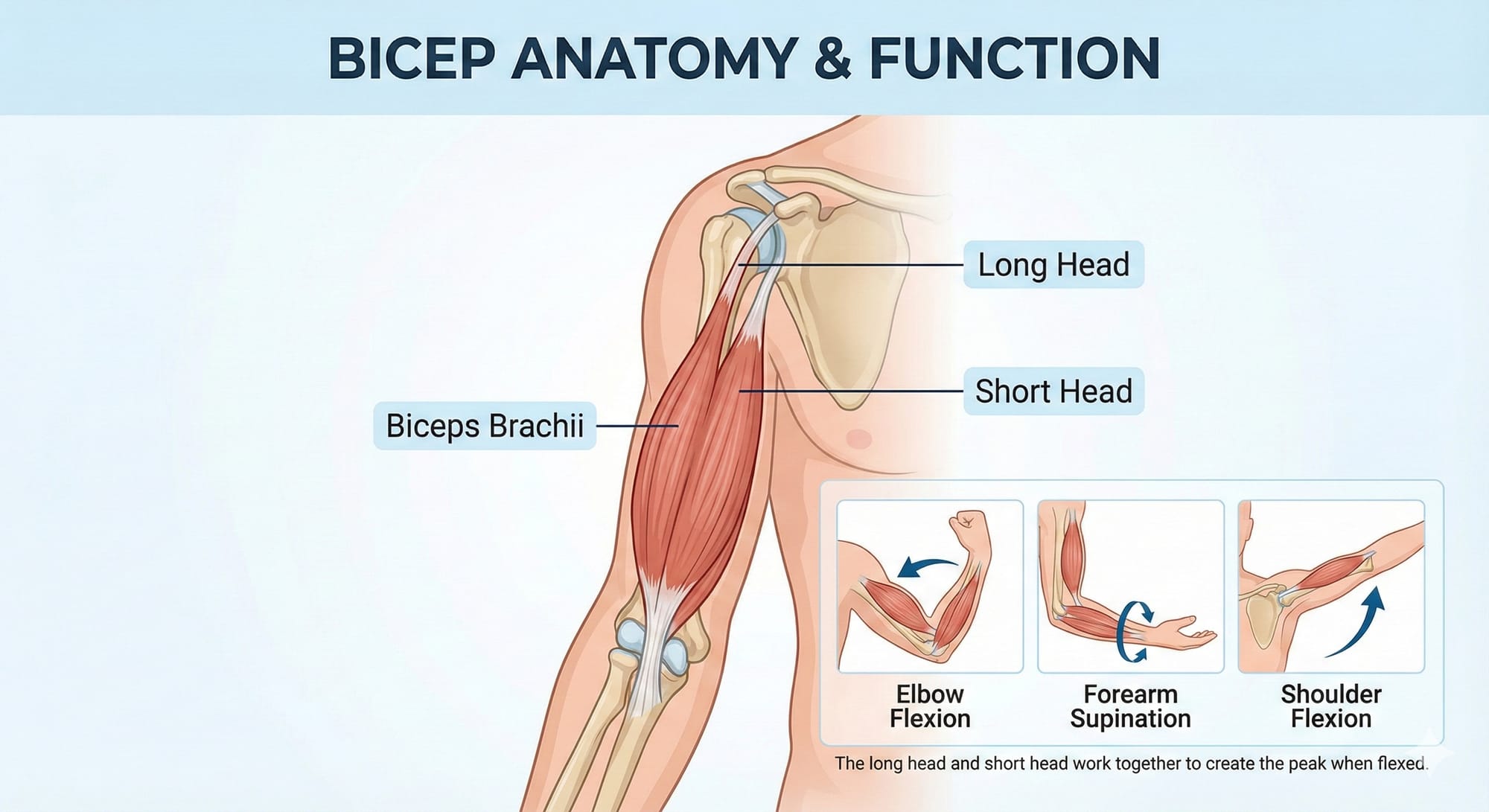Bicep Growth Calculator

Accurate Bicep Measurement Guide
Relaxed Measurement Method
Stand with your arm hanging naturally at your side, completely relaxed. Wrap the measuring tape around the widest part of your upper arm, typically 3-4 inches below your armpit. Ensure the tape is snug but not tight enough to compress the skin.
Flexed Measurement Method
- Sit at a table and rest your elbow on the surface
- Make a fist and curl your forearm toward your shoulder
- Flex your bicep as hard as possible
- Wrap the measuring tape around the highest point of the bicep
Important Measurement Tips
General Guidelines
- Use a flexible, non-stretchy measuring tape
- Measure in the morning for most accurate results
- Take measurements with bare skin or very light clothing
- Keep the measuring tape parallel to the floor
For Best Results
- Have someone help you measure for greater accuracy
- Record measurements for both arms, as they may differ
- Take multiple measurements and average the closest two
- Maintain consistent measurement conditions
Common Mistakes to Avoid
- Don't compress the skin with the tape
- Avoid measuring after a workout when muscles are pumped
- Don't measure over thick clothing
- Never pull the tape too tight
Recording Your Progress
Create a tracking system that includes:
- Date of measurement
- Left and right arm measurements
- Whether measured flexed or relaxed
- Time of day measured
Understanding Bicep Anatomy and Function

Your biceps are complex muscles that perform three main functions: elbow flexion, forearm supination, and shoulder flexion. The biceps brachii consists of two heads - the long head and short head - working together to create that coveted peak when flexed. Understanding this anatomy is crucial for targeting your training effectively.
The Foundation: Key Exercises for Bicep Development
Compound Movements
The weighted chin-up stands as one of the most effective compound exercises for bicep development. This movement engages all three functions of the biceps while allowing for progressive overload. When performing chin-ups, use a supinated grip (palms facing you) to maximize bicep activation.
Isolation Exercises
Research has identified the concentration curl as the most effective isolation exercise for bicep activation4. Other essential movements include:
- Barbell curls for heavy loading
- Incline dumbbell curls for long head emphasis
- Cable curls for constant tension
- Hammer curls for brachialis development
Training Variables for Optimal Growth
Volume and Frequency
Train biceps 2-3 times per week, allowing at least one day of rest between sessions. Begin with one set of each exercise and progress to 2-3 sets as strength improves. Aim for 8-12 repetitions per set for optimal hypertrophy.
Progressive Overload
To stimulate continuous growth, gradually increase either:
- Weight used
- Number of repetitions
- Sets performed
- Training frequency
- Time under tension
Nutrition for Bicep Growth
Protein Requirements
Consume adequate protein to support muscle repair and growth. High-quality protein sources include:
- Chicken breast (26g protein per 3oz serving)
- Salmon (rich in omega-3s and protein)
- Eggs (complete amino acid profile)
- Greek yogurt (fast and slow-digesting proteins
Meal Timing
Consume protein-rich meals or shakes within 30-60 minutes post-workout to optimize the anabolic window5. This timing helps maximize nutrient uptake and muscle recovery.
Supplementation Strategy
Core Supplements
Several supplements can support your bicep growth goals:
- Creatine: The most effective supplement for muscle gain
- Whey Protein: Fast-absorbing post-workout protein
- Casein: Slow-digesting protein ideal before bed
Advanced Training Techniques
Intensity Methods
Incorporate these techniques to break through plateaus:
- Drop sets
- Peak contraction holds
- Cheat curls for eccentric overload
Form and Execution
Maintain strict form to maximize results:
- Keep upper arms stationary
- Focus on full range of motion
- Control the negative portion
- Squeeze at peak contraction
Recovery and Growth
Rest Periods
Allow adequate recovery between bicep training sessions.
Signs of proper recovery include:
- Reduced muscle soreness
- Restored strength levels
- Improved performance
Sleep and Recovery
Quality sleep is crucial for muscle growth and recovery. Aim for 7-9 hours per night to optimize hormone production and muscle repair.
Common Mistakes to Avoid
- Using momentum instead of muscle control
- Neglecting proper form for heavier weights
- Insufficient recovery time
- Inadequate protein intake
- Over-relying on isolation exercises
Tracking Progress
Monitor your bicep development through:
- Regular measurements
- Progress photos
- Strength improvements
- Exercise performance
Sample Bicep Workout Routines
Beginner Routine
| Exercise | Sets | Reps |
|---|---|---|
| Barbell Curls | 3 | 10-12 |
| Hammer Curls | 3 | 10-12 |
| Cable Curls | 3 | 12-15 |
Advanced Routine
| Exercise | Sets | Reps |
|---|---|---|
| Weighted Chin-ups | 3 | 8-10 |
| Incline Curls | 3 | 10-12 |
| Concentration Curls | 3 | 12-15 |
| Cable Hammer Curls | 3 | 15-20 |
Nutrition Planning
Daily Macronutrient Focus
- Proteins: Essential for muscle repair and growth
- Carbohydrates: Fuel for intense training
- Healthy Fats: Hormone production support
Key Foods for Growth
- Lean meats
- Fish
- Eggs
- Complex carbohydrates
- Healthy fats from nuts and avocados
Long-term Success Strategies
Consistency
Maintain consistent training and nutrition habits. Results come from sustained effort over time, not sporadic intense periods.
Progressive Programming
Regularly adjust your training program to prevent plateaus and maintain progress. This includes varying exercises, rep ranges, and intensity techniques.
Mind-Muscle Connection
Develop a strong mind-muscle connection through focused training. This enhances muscle activation and growth potential3.
Conclusion
Building impressive biceps requires a comprehensive approach combining proper training, nutrition, and recovery strategies. Use this guide alongside your bicep growth calculator to optimize your results. Remember that sustainable progress comes from consistent application of these principles over time.














